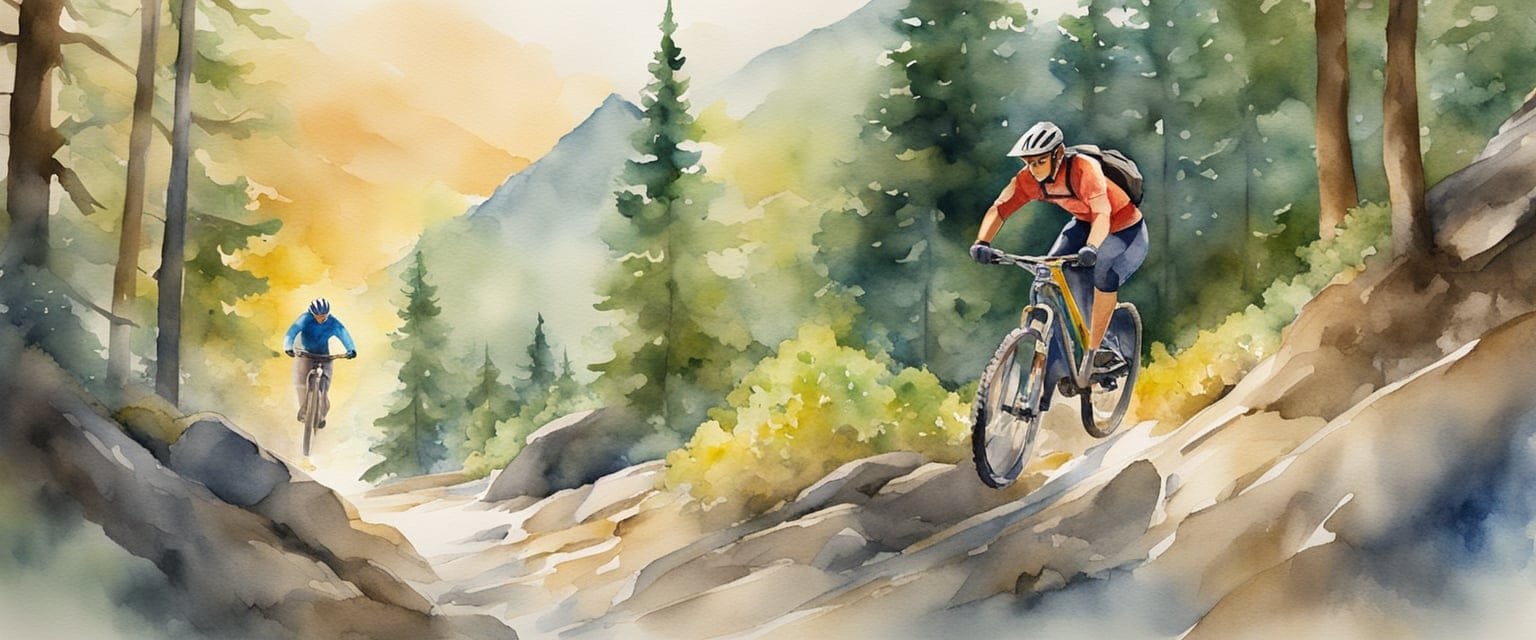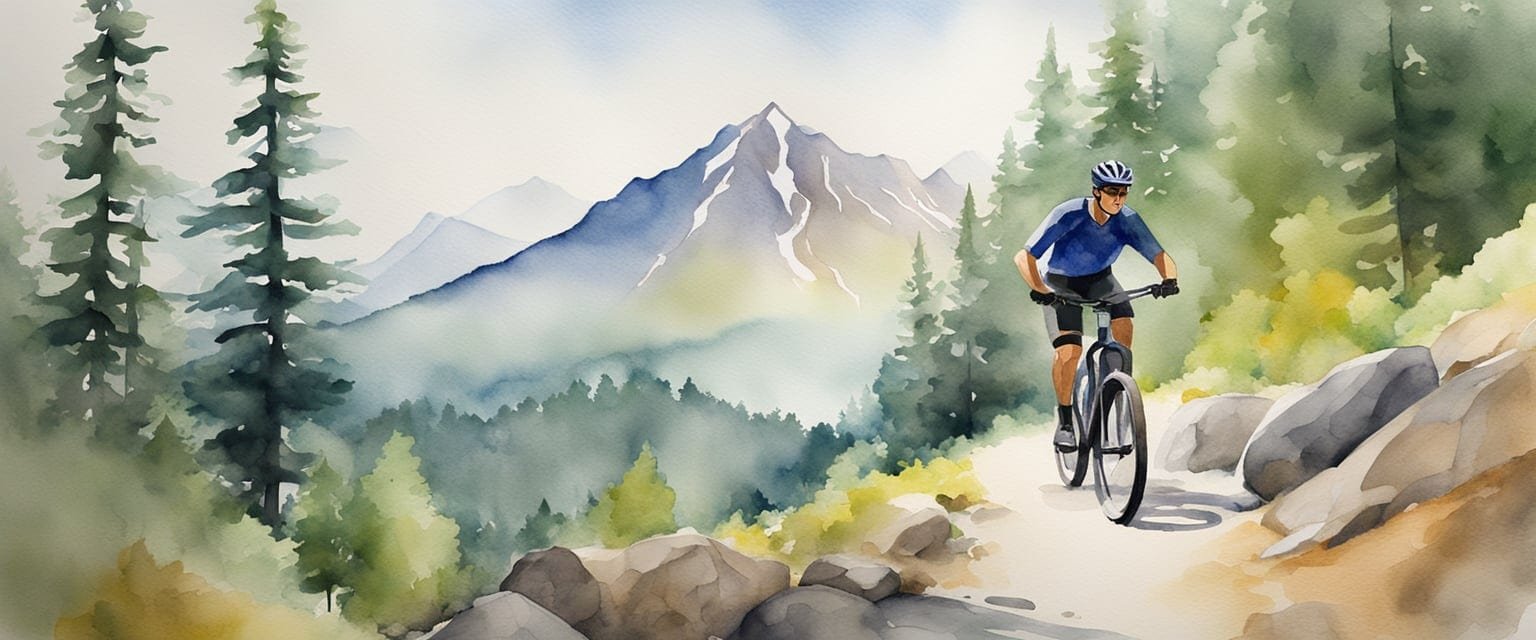Mountain biking has become an exciting part of the Olympic Games since its introduction in 1996. In this ultimate guide, I will cover everything you need to know about Olympic Cycling Mountain Bike, from its rich history to the athletes to watch in Paris 2024. Whether you’re a seasoned fan or new to the sport, I aim to make this information clear and engaging.

As I explore the unique challenges of mountain biking competitions, I will highlight the rules, the racing format, and the thrilling venues that set the stage for these events. Knowing the key aspects of this sport will enhance your experience and appreciation as you follow the races and the incredible athletes participating.
Join me on this journey through the evolving landscape of Olympic mountain biking and discover the passion that fuels this incredible sport.
Key Takeaways
- Olympic mountain biking began in Atlanta 1996 and has evolved significantly since then.
- Understanding the racing format and rules is essential for appreciating the competition.
- Paris 2024 promises to showcase top athletes and unforgettable moments in mountain biking.
History of Mountain Biking in the Olympics
Mountain biking first captured my attention at the Olympics during its debut. This section explores how the sport evolved, its journey into the Olympic Games, and some memorable moments that have defined it.
Evolution of the Sport
Mountain biking started gaining popularity in the 1970s. Riders used modified bicycles to tackle rough trails, combining cycling with outdoor adventure.
By the late 1980s, organized races began to emerge, showcasing the sport’s growing appeal.
In 1990, the International Cycling Union (UCI) recognized mountain biking as a distinct discipline.
This paved the way for mountain biking’s formal inclusion in major events, leading to its debut in the Olympics in 1996.
This evolution highlighted the sport’s unique challenges, focusing on endurance and technical skill, setting the stage for its Olympic journey.
Mountain Biking and the Olympic Games
The 1996 Summer Olympics in Atlanta marked a turning point for mountain biking. It was the first time the sport was included in the Olympic program, featuring both men’s and women’s cross-country events.
The competition attracted global attention as athletes rode rugged terrains, navigating steep climbs and rough descents.
Since then, mountain biking has been a staple at every Olympic Games. Each edition brings its own unique challenges, from altitude and climate to the design of the course.
The introduction of new formats, like downhill racing, added excitement and variety. Athletes compete fiercely for a chance to win the coveted gold medal, showcasing amazing skill and endurance.
Notable Olympic Moments
Throughout the years, there have been many unforgettable moments in Olympic mountain biking.
For instance, in 2004, the rivalry between riders led to an intense competition in Athens.
In 2008, the Beijing Olympics introduced an unforgettable course that tested even the best athletes.
The breathtaking performances, like the spectacular win of the Australian rider in 2000 and the thrilling finishes, have made the sport thrilling to watch.
Each Olympic Games adds its chapter to the rich history of mountain biking, celebrating victories that inspire future generations.
Understanding the Discipline
Mountain biking at the Olympics is an exciting event that showcases speed, skill, and strategy. As I explore this discipline, I’ll focus on the specific formats, types of events, and the essential features of cross-country mountain biking.
Cross-Country Mountain Biking
Cross-country mountain biking is the main event for Olympic mountain biking. It consists of a race on varied terrain, including steep climbs, descents, and tight turns. Competitors ride laps on a set course that typically ranges from 25 to 30 kilometers in distance.
The goal is to complete the course in the shortest time possible. Riders need endurance, as races can last over an hour. I admire how athletes demonstrate incredible strength and determination while navigating obstacles like rocks and roots.
Racers are classified based on gender, and separate events are held for men and women. The competitive atmosphere is electric, and I love watching how each athlete tackles the challenges along the way.
Deciphering the Track
The track for Olympic mountain biking is designed with various features to test riders’ skills. It often includes technical sections, fast descents, and challenging climbs. I find that understanding the course layout can make a big difference in performance.
Tracks are typically marked with color-coded flags and signs that indicate important race points. Riders must learn the best lines to take during races to save time. The strategy is just as crucial as speed since knowing when to push hard or conserve energy can determine the race’s outcome.
The conditions of the track can change throughout the event, adding another layer of complexity. Weather can affect grip and visibility, so being adaptable is key.
Categories and Events
At the Olympics, mountain biking includes specific categories based on gender and age. Competitions are primarily for elite athletes. I find strong competition between nations, with countries like France and Switzerland often excelling in this sport.
The Olympic program features different events within mountain biking, with cross-country being the main focus. Each event has its own unique format, like individual time trials or mass start races. Watching these athletes push their limits inspires me, as they showcase not only their skills but also their love for the sport.
I appreciate how these events bring together people who share a passion for mountain biking while competing for their countries.
The Olympics and Paris 2024
I’m excited to dive into the upcoming Olympic Games in Paris 2024, especially with cycling mountain bike events. With a beautiful backdrop in France, I look forward to the unique venue and what new things are happening in this year’s competitions.
Cycling at Paris 2024
The cycling events at Paris 2024 will showcase some of the best athletes in mountain biking. I can’t wait to watch the thrilling races that will feature both men’s and women’s competitions. The races will take place on July 28 and 29, giving fans back-to-back excitement.
The mountain bike course will challenge riders with its technical features and varying terrain. Athletes will need skills and endurance to conquer this demanding event. I know many fans are eager to see if reigning champions can defend their titles or if new stars will rise.
Elancourt Hill – the Venue
Elancourt Hill is the chosen venue for the mountain biking events at Paris 2024. Located in the Paris region, it offers a stunning natural landscape that will enhance the racing experience. The site has a mix of hills, trails, and wooded areas that make it perfect for mountain biking.
I’ve heard that the venue will be set up to ensure not only competitive racing but also a great viewing experience for fans. Spectators can look forward to seeing athletes navigate a challenging course. The environment here will add to the excitement, making it a truly memorable event.
What’s New in 2024?
Paris 2024 promises some exciting new features in the cycling mountain bike competition. One notable highlight is the inclusion of innovative technology and enhanced broadcast methods. Fans around the world will have better access to live coverage and real-time updates.
Additionally, sustainability is a key focus for this year’s Games. I appreciate that the organizers are committed to reducing their environmental impact. This will be visible in how the events are run and the efforts made to protect the surrounding nature at Elancourt Hill.
It’s thrilling to think about what’s in store for the mountain biking competition at the Olympics!
Athletes to Watch

In the exciting world of Olympic Mountain Biking, certain athletes stand out due to their skills, achievements, and potential. Here are some of the key riders to keep an eye on during the upcoming Paris 2024 Games.
Rising Stars
I’m particularly excited about the young talent emerging in the sport. Charlie Aldridge is one to watch. At just 21 years old, he has already made a name for himself with impressive performances on the global stage. I believe he can make a real impact at the Olympics.
Evie Richards is another rising star in women’s mountain biking. At only 26, she has shown fantastic skills and determination. She won a medal at the World Championships and proved she can compete with the best. The energy and passion she brings to the sport make her a favorite among fans.
Veteran Champions
The Olympics is not only about newcomers; seasoned athletes often shine. Tom Pidcock, the reigning World Champion, has my attention. He’s known for his aggressive style and strategic racing. His experience, along with his recent successes, puts him in a strong position to defend his title.
Among women’s competitors, Jolanda Neff is a veteran who cannot be overlooked. With multiple podium finishes, she brings a wealth of experience and a competitive edge. Watching her race is always thrilling, and her ability to handle pressure makes her a strong contender for medals.
Team Dynamics
Teamwork can play a significant role in Olympic races. I’m interested in how countries like Switzerland and the UK will leverage their team dynamics. For instance, the British team often trains together, enhancing their cohesion.
In the women’s division, the collaboration among riders can lead to strategic advantages. Their ability to support one another during races can be crucial for securing medals. The interaction and trust between team members can boost their confidence and performance.
As we look forward to these thrilling races, I’m eager to see how these athletes and their teams will perform on the world stage.
Training and Techniques
Training effectively is crucial for success in Olympic Mountain Biking. I focus on various aspects, like preparation and essential skills, to become a faster and more stable rider.
Preparation for the Olympics
Preparing for the Olympics requires a solid training regimen. I typically train five to six days a week, combining endurance rides, strength training, and technical skills practice.
Endurance Rides: These help build my stamina for long races. I aim for longer distances at a moderate pace.
Strength Training: This focuses on core stability and leg strength, including exercises like squats and lunges.
Technical Skills: I spend time on rough terrain to improve my handling skills. This includes practicing sharp turns, jumps, and obstacle navigation.
Balancing these elements ensures I’m race-ready and can handle the challenges of the Olympic course.
Mountain Bike Skills and Strategies
To be successful, I emphasize specific skills and strategies. One key technique is maintaining speed through corners. I practice leaning into turns while keeping my body balanced.
Body Positioning: Good body positioning enhances my stability. I learn to adjust my weight based on the terrain.
Braking Techniques: I focus on using both brakes smoothly to control my speed without losing momentum.
Race Strategy: During races, I study my competitors. Understanding their strengths helps me find my opportunities to push ahead.
By honing these skills, I feel more confident and prepared.
Mountain Bike Equipment
When it comes to mountain biking in the Olympics, the right equipment is essential for performance and safety. I’ll explore the key components of mountain bike gear and highlight the latest innovations in technology that enhance the riding experience.
Bikes and Gear
The mountain bike itself is the most crucial piece of equipment. These bikes are typically designed with features like rear suspension to absorb shocks from rough terrain. My favorite type is a full-suspension bike, which offers better control and comfort.
Handlebars play a vital role in steering and stability. I prefer wider handlebars for a more secure grip, especially during fast descents. The tires are also important; they should be knobby for traction on rocky surfaces. A good tire pressure can make a big difference in grip and speed.
Accessories like helmets, gloves, and protective pads are equally important. A well-fitted helmet can protect my head during a fall. Gloves improve grip and comfort, while pads can prevent injuries during tough rides.
Innovations in Technology
Technology has transformed mountain biking, making it safer and more efficient. For instance, advancements in suspension systems have improved shock absorption significantly. Models with adjustable suspension allow me to adapt settings based on the terrain, enhancing my ride.
Another exciting innovation is the development of lightweight materials. Many mountain bikes use carbon fiber, which reduces weight without sacrificing strength. This helps me go faster and easier uphill.
Smart technology is also emerging in mountain biking. Some bikes come with integrated sensors that track performance metrics, allowing me to measure speed, distance, and heart rate. This feedback can be invaluable for training and improving my skills.
Understanding these aspects of mountain bike equipment can make a big difference in my overall experience.
Racing Format and Rules
In mountain biking at the Olympics, the racing format is structured around competition rules meant to ensure fair play and excitement. Riders navigate challenging courses while completing multiple laps. Knowing the specifics can enhance my understanding of how the races unfold.
Competition Structure
The mountain biking event features a single race for each gender. All riders start simultaneously, maintaining a competitive edge from the beginning. The course is designed with various obstacles, such as steep climbs and sharp turns.
Each race consists of multiple laps that vary in length. Typically, riders aim to complete the course in the shortest time. This structure creates a dynamic setting where strategy is crucial.
Time Trial Explained
In the time trial, athletes compete individually instead of in a mass-start format. Riders tackle the course one at a time, and the goal is to achieve the fastest time. This format helps to minimize chaos, allowing each cyclist to focus on their performance.
The time trial usually takes place on a separate day from the main race. Riders must maintain stamina and speed over the course’s full length. With mountains, mud, and technical sections, every second counts.
Scoring and Ranking
Scoring in mountain biking is straightforward. The primary focus is on the finish time: the fastest rider wins the race. In addition to overall time, I often think about the possibility of a rider being lapped.
If a rider is lapped by the leader, they may not complete the race. Rankings also consider both race finishes and time trials throughout the competition. Points can add up based on performance in each event, impacting overall standing.
Mountain Biking Venues

Mountain biking venues for the Olympics are often set in stunning natural landscapes. These locations not only offer challenging courses but also showcase breathtaking views. Let’s dive into some of the iconic trails and examine the terrain and conditions that make these events special.
Iconic Olympic Trails
One of the most memorable mountain biking trails is located at Élancourt Hill, southwest of Paris. This venue has hosted the Olympic mountain biking competition since its introduction in 1996.
I love how the trails wind through dense forests, providing a mix of technical challenges and rewarding scenery. Riders must navigate sharp turns, steep climbs, and descents that test their skills and endurance. Each trail is designed to highlight the strength and agility of the athletes.
The courses can vary in length and difficulty, but they all feature natural obstacles like rocks and roots, making for an exciting race.
Terrain and Conditions
The terrain for Olympic mountain biking is usually rugged. Riders face a variety of surfaces, from dirt paths to rocky sections. This diverse landscape helps showcase the athletes’ abilities to handle challenging conditions.
Weather can also play a significant role. Rain can turn trails muddy, adding another layer of difficulty. I find that the combination of factors—like elevation changes and trail features—can create unique racing experiences.
Riders must be prepared for anything as they tackle the varying conditions on race day. The mixture of technical, hilly terrain and natural elements makes Olympic mountain biking an exhilarating sport for both the competitors and the viewers.
Beyond the Olympics

The excitement of mountain biking doesn’t stop at the Olympics. I also enjoy exploring other key events and circuits that showcase the sport’s skill and thrill. Two major areas to consider are the World Championships and the cycling professional circuit.
World Championships
The UCI Mountain Bike World Championships is a premier event that attracts the best riders from around the globe. Held annually, it includes multiple disciplines, such as cross-country and downhill racing. The competition showcases top talent, making it a thrilling watch.
Riders compete for the title of world champion, which brings pride to their nations. Athletes like Nino Schurter and Annika Langvad have made significant impacts at these championships. I find it exciting how different terrains and conditions challenge riders each year. Along with mountain biking, the championships feature road cycling, BMX, and track cycling events. This variety creates a rich atmosphere for all cycling fans.
Cycling’s Professional Circuit
Professional mountain biking also includes various circuits, such as the UCI Mountain Bike World Cup. These events happen throughout the year and allow riders to earn points and rankings. I love watching how athletes adapt to different trails across multiple countries.
In addition, riders often compete in both mountain biking and other cycling disciplines, like road cycling or BMX. This cross-discipline skill set makes top athletes versatile and adds to the excitement. The professional circuit also serves as a platform for new talent to emerge, keeping the sport fresh and competitive.
Fan Experience
Attending the Olympic Cycling Mountain Bike events offers an exciting experience for fans. From following the action live to engaging with fellow cycling enthusiasts, there’s much to enjoy in this vibrant atmosphere.
Following the Action
As a fan, keeping up with the races is essential. I love checking out live updates on various platforms for the latest news and results. Major sports websites often provide real-time tracking during events. I make it a point to watch highlights and videos that showcase key moments from the races.
Additionally, social media is a great tool. I follow official Olympic accounts and athletes to get behind-the-scenes content and personal insights. Interactive features during the event, like polls and Q&A sessions, help me feel connected and engaged while following the action.
Engaging with the Community
The community aspect is one of my favorite parts. I enjoy joining forums and attending local watch parties with other cycling fans. Sharing views and discussing results create a vibrant atmosphere.
Many fans also participate in online groups to exchange tips on where to watch events and what to look out for. I often post about my predictions and reactions, which sparks lively discussions online.
Being part of such a passionate community makes the experience even more special. Engaging with fellow fans enhances my enjoyment of the Olympic Cycling Mountain Bike events.
Resources and Further Reading
When diving into Olympic Cycling Mountain Biking, having the right resources can enhance your understanding of the sport. I’ve gathered some of the best places to find expert advice, insights from top athletes, and valuable cycling content to keep you informed and inspired.
Expert Buying Guides
Finding the right mountain bike and gear can be overwhelming. I recommend checking various expert buying guides to help narrow down your choices. These guides cover everything from the latest bike models to essential accessories like helmets and protective gear.
Look for reviews that compare brands and prices. For instance, the Leadout Newsletter often features in-depth product reviews and comparisons. Understanding specs, features, and the pros and cons of each item can help make a more informed decision.
Don’t forget to consider what professional cyclists like Demi Vollering and Remco Evenepoel prefer. Their choices can give insights into high-performance gear suitable for competitive conditions.
Interviews and Insights
Real-life experiences can provide learning moments. I often seek out interviews with both professional athletes and experts in the cycling community. These conversations typically highlight personal stories, training routines, and strategies that shape successful competitors.
Places like Cycling Weekly and Cycling News regularly feature interviews that delve into the minds of leading cyclists. They discuss everything from race preparation to overcoming challenges. Hearing from athletes directly allows me to connect with their journeys and apply their advice to my own cycling experience.
I find that following these insights can not only motivate me but also sharpen my technique and tactical approach on the trails.
Subscribing to Cycling Content
Staying updated with the latest news in cycling is essential. I recommend subscribing to cycling-specific publications and newsletters. These resources provide race content, insights, and trends within the sport.
The Leadout Newsletter is one option I often rely on for timely updates. It includes race results, upcoming events, and expert analyses. Many online platforms also offer free articles and expert opinions that keep me informed.
Joining online forums and following social media accounts related to mountain biking can further enrich my knowledge. Engaging with the biking community has also helped me discover more about events like the Olympics and trends that influence gear choices.
By tapping into these resources, I enhance my understanding and appreciation for Olympic Cycling Mountain Biking.
Frequently Asked Questions

I often get questions about Olympic mountain biking, from the events involved to the types of bikes used. Here are some common inquiries that many fans and newcomers have.
What are the different events in Olympic mountain biking?
In the Olympics, there are two main events in mountain biking: Cross-Country and Downhill. Cross-Country is a timed race on a course with varied terrain. Downhill involves racers descending a steep course with obstacles, focusing on speed and skill.
Can you explain the rules of Olympic mountain biking?
The rules cover various aspects, such as race format, course specifications, and equipment standards. Each race has specific lap distances and time limits, with penalties for rule violations. Riders must also wear safety gear like helmets.
Where can I find the schedule for the Olympic mountain biking events?
You can find the schedule for the Olympic mountain biking events on the official Olympics website or sports news outlets. These sources provide up-to-date information about race times and dates for both Cross-Country and Downhill events.
Who are the top contenders for the 2024 Olympic mountain biking?
Top contenders often include athletes with proven records in international events. Riders like Tom Pidcock and Nino Schurter are among those expected to perform well in the upcoming games. Each athlete brings unique skills and experiences to the competition.
What kind of bikes do athletes use in Olympic mountain biking?
Athletes typically use lightweight, high-performance mountain bikes designed for speed and agility. These bikes feature specific tires for grip and suspension systems to absorb shocks on rough terrain. Each rider customizes their bike to fit their racing style.
How does the point system work in Olympic mountain biking?
The point system varies depending on the competition format. In some races, the first finishers earn the most points, which accumulate over the season or event. These points can impact rankings and qualifications for future competitions.

